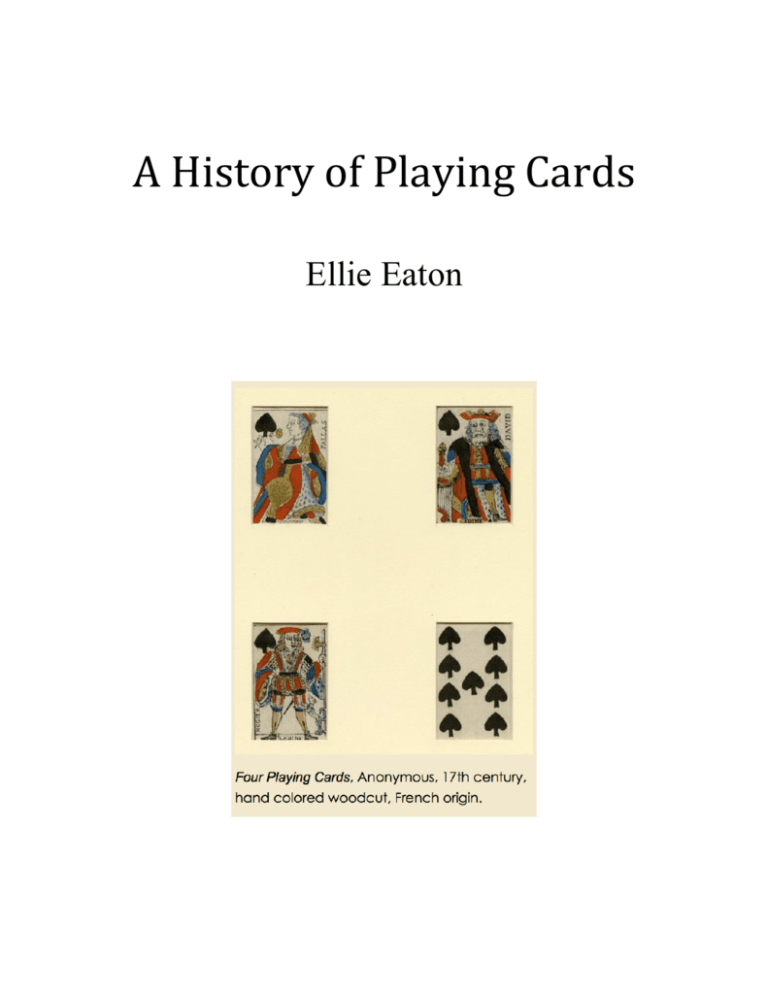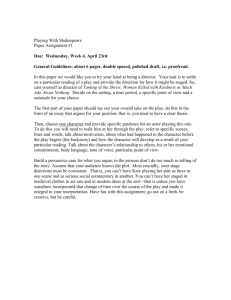! A!History!of!Playing!Cards!
advertisement

! A!History!of!Playing!Cards! Ellie Eaton ! ! ! Eaton!1! Ellie Eaton ARTH 165 April 15, 2014 The History of Playing Cards “Just think of what we would be if we had no cards! How boring and unsociable is the life of those who have to do without this invention!” – Bürgerfreund, 17761 The Fleming Museum in Burlington, Vermont currently holds a set of four playing cards dating to the seventeenth century. They are readily recognizable to the modern eye as a king, queen, jack (or “valet”) and nine of spades. The medium is handcolored woodcut on paper and the artist is anonymous. They are estimated to have been created in the seventeenth century. All of the cards share a common color scheme using bright red, blue in various levels of saturation, and a darker, mustard-toned yellow. Black is used primarily for the outlines and the suit symbols but it occasionally appears as an accent color. Modern playing cards all follow essentially the same format: 52 cards divided into four suits (spades, clubs, diamonds, and hearts) of two colors (black and red). Each suit has three face cards, an ace, and numbers one through ten. The cards from the Fleming set appear to follow this pattern (though there are not enough cards available to be certain), but many others show massive variation in number, suit, and design of face cards, particularly by region.2 !!!!!!!!!!!!!!!!!!!!!!!!!!!!!!!!!!!!!!!!!!!!!!!!!!!!!!!! 1 Detlef Hoffman, The Playing Card; An Illustrated History, (Greenwich, CT: New York Graphic Society, 1973), 9. 2 Laura A Smoller, "Playing Cards and Popular Culture in Sixteenth-Century Nuremberg,” The Sixteenth Century Journal 17.2 (1986): 186. ! Eaton!2! The king is depicted as an older man with a full beard and crown, wearing elaborate, ermine-lined robes and holding what appears to be a stringed instrument. His card is labeled “Cadine” at the bottom center and “David” along the upper right-hand side. David is likely a reference to the biblical king. The queen is shown in profile, also wearing ermine and holding a flower in her right hand. Placed in front of her body is what looks like a large coin. Her card bears the “Cadine” label and “Pallas” is written on the upper right-hand side. Pallas is a reference to the Greek goddess Pallas Athena (who, according to William Chatto, is “but an emblem of Joan of Arc”).3 The figure of the jack is standing and is unencumbered by the bulky robes of the first two. One hand is on his hip and the other holds a halberd. A dog is pawing at his leg. His card has the “Cadine” label and “Hogier” is written on the lower left-hand side. Hogier is a reference to “Ogier le Danois,” a legendary literary character. 4 Finally, the nine of spades is most simply depicted, with four spades on each side (vertically) and one in the center. The origin of playing cards is hazy and obscured by a historically European bias in their study. However, they are typically considered to have first come into use in China during the T’ang period around the seventh or eighth century AD. The earliest material evidence is the Turfan card, which is estimated to date back to the eleventh century as well. 5 Outside of these, however, there is little other evidence that exists to trace the history of playing cards from their earliest known source to Europe. Detlef Hoffman identifies the first “reliable” evidence of card playing in Europe by referring to a 1376 Florentine decree prohibiting the game of “naibbe,” whose name !!!!!!!!!!!!!!!!!!!!!!!!!!!!!!!!!!!!!!!!!!!!!!!!!!!!!!!! 3 William Andrew Chatto, Facts and Speculations on the Origin and History of Playing Cards, (London: John Russell Smith, 1848), 209. 4 Chatto, Facts and Speculations on the Origin and History of Playing Cards, 208. 5 Hoffman, The Playing Card; An Illustrated History, 52 ! Eaton!3! likely originated from a card called “naib” in an early Arab set.6 Trevor Denning points to a similar edict regarding the same game in Catalonia a few years prior, in 1371, and proposes that Spain might have been the route through which playing cards were introduced to the rest of Europe, perhaps through the Arab kingdoms stretching up from North Africa through the Iberian peninsula.7 Much of the earliest historical evidence for the existence of cards stems from records of their bans by both the state and the Church. Andrew Lo notes four separate decrees throughout Europe in 1377 in Paris, Florence, Basle, and Siena.8 Aside from this, historians have also used linguistic evidence for words relating to cards in a region’s native language as a way to attempt to uncover more concrete information. Lehmann-Haupt credits Johannes Gutenberg, the inventor of the printing press, with a major role in the development of copper engraving. Copper engraving was the method through which early playing cards were produced.9 Such playing cards were rife with animal iconography, as evidenced in the fifteenth century Middle-Rhenish Mainz Bible and miniatures printed in later manuscripts such as the Cleves Hours. 10 The set of playing cards currently at the Fleming were printed in woodcut, a medium that was reached the peak of its popularity in sixteenth century Germany (where artists such as Albrecht Duhrer and Hans Holbein achieved great success) and suffered !!!!!!!!!!!!!!!!!!!!!!!!!!!!!!!!!!!!!!!!!!!!!!!!!!!!!!!! 6 Hoffman, The Playing Card; An Illustrated History, 12. 7 Trevor Denning,The Playing-Cards of Spain: A Guide for Historians and Collectors, (Madison, NJ: Fairleigh Dickinson University Press, 1996), 1. 8 Andrew Lo, “The Game of Leaves: An Inquiry into the Origin of Chinese Playing Cards,” Bulletin of the School of Oriental and African Studies, University of London 63.3 (2000): 389. 9 Hellmut Lehmann-Haupt, Gutenberg and the Master of the Playing Cards, (New Haven: Yale University Press, 1966), 3. 10 Ibid. ! Eaton!4! from a decline during the latter half of the seventeenth century.11 It was primarily used for illustration and print engravings, but was not regarded on nearly the same level as painting or sculpture. This is likely due to the fact that easily reproducible works did not carry the same weight and ostensibly did not require the same level of creative merit. Lehmann-Haupt says that the medium “played a humble role as maid of all work,”12 since woodcuts were most often used for reproduction of works in other media. This reproductive function, while diminishing the medium as a liberal art, is important as it allowed wider access and diffusion for playing cards. The use of woodcut allowed card makers to print an entire deck on a single sheet, and then color them in using a stencil.13 Card-makers throughout history have capitalized on the potential for variety as a way to incorporate additional information and thus served a number of functions outside of providing a common leisure activity. Secondary purposes included education, propaganda, advertising, fortune telling, and art (as in decoration). Didactic uses seem the most common and most compelling. In “The Art of the Playing Card,” Wynne and Mayor detail some instances of educational usage. A set of cards from Ferrara in the 1460s included visual information about the planets, the Apollonian Muses, the virtues, the arts and sciences, and the stations of man.14 Even Louis XIV was given packs of cards as a child to aid in his learning of subjects like geography, mythology, and royal ancestry.15 Playing cards as educational tools can also be seen in the case of Thomas Murner, a !!!!!!!!!!!!!!!!!!!!!!!!!!!!!!!!!!!!!!!!!!!!!!!!!!!!!!!! 11 Hellmut Lehmann-Haupt, An Introduction to the Woodcut of the Seventeenth Century, (New York: Abaris, 1977), 19. 12 Ibid, 13. 13 Smoller, "Playing Cards and Popular Culture,” 185. 14 Marjorie G. Wynne and A. Hyatt Mayor, “The Art of the Playing Card,” The Yale University Library Gazette 47.3 (1973): 144. 15 Ibid, 145. ! Eaton!5! university professor who used cards to help teach his students to such success that he was suspected of witchcraft.16 From the very beginning of the popularity of playing cards in Europe, there was a response from the Church condemning the practice. In 1377, just a few short years after the date assigned to the possible introduction of cards, a monk wrote a treatise dealing with the moral aspects of card playing.17 In 1423, St. Bernardin of Siena preached against them (along with other games and leisure activities and items). An early sixteenth century woodcut by Hans Schaufelein shows the burning of such objects as trifles of vanity and frivolity, going against the ideals of an ascetic life.18 However, Smoller attests that the Reformation spanning the sixteenth and seventeenth centuries had little effect on cardmakers and card-players.19 A statement by Martin Luther reaffirms this, as he notes that in his youth, “all games were prohibited . . . and people were required to make confession of their gaming” but that when he spoke in the sixteenth century, “these things are the vogue, and they are defended as exercises for the mind.”20 It can be concluded that the Church eventually accepted the practice of card playing, as long as it was removed from the context of gambling. Smoller also to describe the shared culture of card playing and the unifying effect that playing cards had as a leisure activity spanning status and socioeconomic class. The earliest playing cards in Europe were generally reserved for the wealthy and elite. However, this separation rapidly eroded, due to what Smoller refers to as “their universal !!!!!!!!!!!!!!!!!!!!!!!!!!!!!!!!!!!!!!!!!!!!!!!!!!!!!!!! 16 Smoller, "Playing Cards and Popular Culture,” 187. 17 Ibid, 184. 18 Hoffman, The Playing Card; An Illustrated History, 12-13. 19 Smoller, “Playing Cards and Popular Culture,” 183. 20 Ibid, 187. ! Eaton!6! popularity and the types of images depicted on them.”21 The printing process made cards widely accessible and easily disseminated, bringing them to the hands of the lower and middle classes. In applying this information to the set of cards at the Fleming, one can deduce a few major points of interest. The apparel of the courtly figures and the fleur-de-lis pattern visible on the cards suggests that they might have been produced in France, though the museum does not have any record as to their provenance. Most suggestive of French origin, however, is William Chatto’s record of the standardized French coat cards. During the reign of Louis XIV, cards followed a model that can be identified by the figures represented on the face cards. Different suits showed different historical and legendary leaders, and those represented on this set’s spades align perfectly with the “pique” suit described in Chatto.22 This also suggests an early to mid seventeenth century time frame for production. A reproduction of a set of Parisian cards from 1790 seen in Wynne and Mayor bears a striking resemblance to the set at the Fleming, down to the faces, attire, and iconography. The authors identify the name “Mandou,” which had been printed on each card like “Cadine,” as the maker of the set.23 It stands to reason, then, that Cadine is the card-maker of the Fleming set. This place and date further solidify the region of the cards as French but the date at the end of the eighteenth century does not help to locate the origin of the Fleming cards in time. !!!!!!!!!!!!!!!!!!!!!!!!!!!!!!!!!!!!!!!!!!!!!!!!!!!!!!!! 21 Ibid. 22 Chatto, Facts and Speculations on the Origin and History of Playing Cards, 208. 23 Wynne and Mayor, “The Art of the Playing Card,” 166. ! Eaton!7! Bibliography Chatto, William Andrew. Facts and Speculations on the Origin and History of Playing Cards. London: John Russell Smith, 1848. Denning, Trevor. The Playing-Cards of Spain: A Guide for Historians and Collectors. Madison, NJ: Fairleigh Dickinson University Press, 1996. Hoffmann, Detlef. The Playing Card; An Illustrated History. Greenwich, CT: New York Graphic Society, 1973. Lehmann-Haupt, Hellmut. Gutenberg and the Master of the Playing Cards. New Haven: Yale University Press, 1966 Lehmann-Haupt, Hellmut. An Introduction to the Woodcut of the Seventeenth Century. New York: Abaris, 1977. Lo, Andrew. “The Game of Leaves: An Inquiry into the Origin of Chinese Playing Cards.” Bulletin of the School of Oriental and African Studies, University of London 63.3 (2000): 389-406. Smoller, Laura A. "Playing Cards and Popular Culture in Sixteenth-Century Nuremberg." The Sixteenth Century Journal 17.2 (1986): 183-214. Wynne, Marjorie G. and A. Hyatt Mayor. “The Art of the Playing Card.” The Yale University Library Gazette 47.3 (1973): 137-184. ! Four Playing Cards, anonymous, 17th century, hand colored woodcut. Eaton!8!






